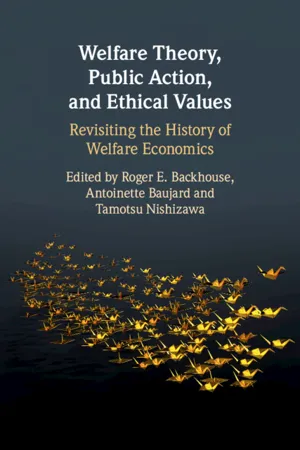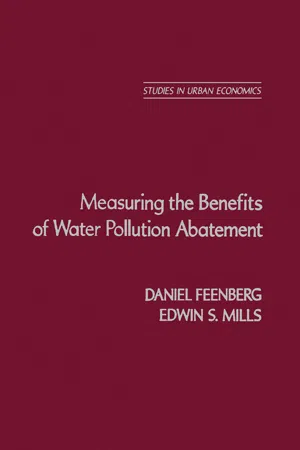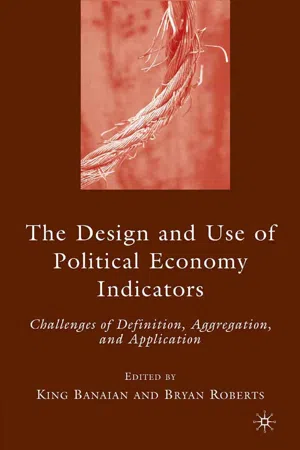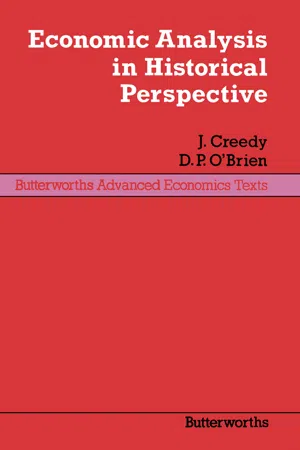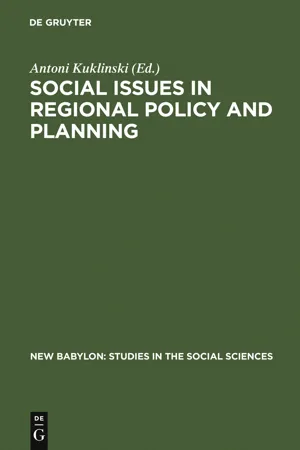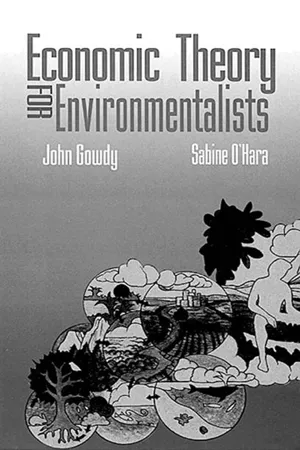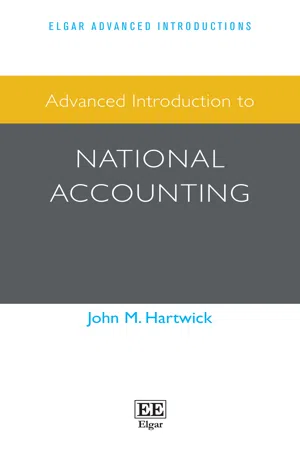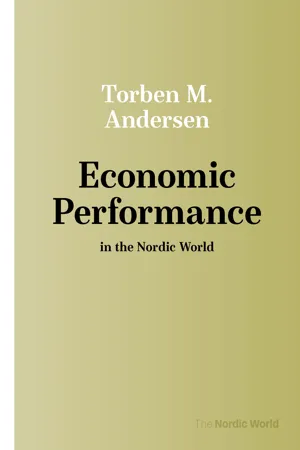Economics
Welfare in Economics
Welfare in economics refers to the overall well-being of individuals and society. It encompasses factors such as income distribution, access to goods and services, and overall quality of life. Economists study welfare to understand how different policies and market conditions impact the standard of living and social welfare of a population.
Written by Perlego with AI-assistance
Related key terms
1 of 5
12 Key excerpts on "Welfare in Economics"
- eBook - PDF
Welfare Theory, Public Action, and Ethical Values
Revisiting the History of Welfare Economics
- Roger E. Backhouse, Antoinette Baujard, Tamotsu Nishizawa(Authors)
- 2021(Publication Date)
- Cambridge University Press(Publisher)
Introduction: Revisiting the History of Welfare Economics Roger E. Backhouse, Antoinette Baujard and Tamotsu Nishizawa 1 Welfare Economics Welfare economics is the part of economics that deals with evaluating states of the world and formulating recommendations for policies that would improve the well-being of society as a whole. It covers not only a body of policy advice but, arguably more important, a body of principles on which such evaluations and recommendations should be based. Economists frequently make the claim that how well-off society is, which we refer to as social welfare, depends solely on the well-being of the individuals making up that society. In other words, if a change does not make any individual better off, then social welfare cannot have increased. The claim made in this book is that whether we are talking about old, new or contemporary welfare economics, when economists have tackled prac- tical problems, they have adopted a much broader range of ethical judge- ments beyond welfarism. For example, they have seen greater equality in the distribution as desirable in itself; they have argued that we should respect the rights of individuals to do certain things; and they have attached importance to the way economic outcomes are achieved. The notion that social welfare depends solely on the well-being, or welfare, of individuals has come to be known as ‘welfarism’. The term ‘welfarism’ appears to have first been used by John Hicks (1959), when he defined it as meaning a concern with ‘economic welfare’, a term used by A. C. Pigou (1920: 11) to denote ‘that part of welfare that can be brought directly or indirectly into relation with the measuring-rod of money’. This excluded considerations such as justice, freedom and rights to which money values could not be assigned. However, the term was not widely used until it was independently invented by Amartya Sen in the late 1970s, 1 - eBook - PDF
Welfare Economics
Towards a More Complete Analysis
- Y. Ng(Author)
- 2003(Publication Date)
- Palgrave Macmillan(Publisher)
In other words, bearing fruit is more important than just shedding light. To apply economics beneficially in government policies and to solve social issues we need some guidelines or criteria. Most practical policy problems are not simple enough to allow easy answers. For example if a change will increase the national income but make it more unequally distributed, is it desirable? If a policy will make certain groups of people better off and others worse off, should it be adopted? Should government revenue be raised more by direct or by indirect taxes? Should we go for freer trade even if that will lead to the collapse of some industries? Is globalisation desirable? Should we tax or regulate pollution? To what extent should we conserve our scarce resources? Is economic growth a good thing? The study of welfare economics can help us to answer these questions, but just what is welfare economics? (Beginners may find the methodological discussion in this chapter rather abstract. Nonetheless they are advised to read it and will come to under- stand it better after they have read a few more chapters. However if they cannot bear to read it, they can restrict their reading to Section 1.5 and go on to Chapter 2 without much loss of continuity. More advanced readers are advised to read the methodological discussion carefully.) 1 1.1 What is welfare economics? Welfare economics is a branch of study that endeavours to formulate prop- ositions that enable us to state that social welfare in one economic situation is greater or lesser than in another. This definition is not much different from the following one by Mishan (1969b, p. 13) ‘Theoretical welfare economics is... that branch of study which endeavours to formulate propositions by which we may rank, on the scale of better or worse, alternative economic situations open to society.’ In fact if we define social welfare as whatever is good, or whatever ought to be maximised, then the two definitions are identical. - Daniel Feenberg(Author)
- 2012(Publication Date)
- Academic Press(Publisher)
2 Welfare Economics and the Basis of Benefit Measurement 1. The Nature of Welfare Economics During the two centuries economics has existed as a distinguishable sci-ence, economists have developed a remarkable body of welfare analysis. The purpose of this chapter is to briefly summarize important results of welfare economics and to show how environmental problems fit into the framework. For a fuller discussion of welfare economics, the reader should consult a good price-theory text, such as Mansfield [30]. Welfare economics is concerned with the relationship between people's welfare and the ways the productive resources available to society are used. It is usual and useful to distinguish between efficiency and equity aspects of welfare economics. Efficiency refers to the ability of the eco-nomic system to satisfy people's needs and wants, given the distribution of property and other productive resources among the people. Equity refers to concerns people have about the distributions of wealth and in-come and to government programs designed to alter these distributions. Almost nothing will be said about equity problems in this book. The reason is not that equity problems are unimportant; in an affluent society they may be even more important than efficiency problems. Instead, the reason is that society has available several mechanisms—specifically tax and transfer programs—that can be well designed to achieve changes deemed desirable in wealth and income distributions. In fact, available evidence and analysis (see Baumol and Oates [2]) suggest that most actual and proposed government environmental protection programs are likely to be mildly regressive. If so, desirable corrections to wealth and income distributions should be made by tax and transfer programs designed for the purpose. Environmental protection programs are poor measures by 19 20 Welfare Economics and the Basis of Benefit Measurement which to achieve distributional goals.- eBook - PDF
- Sidney Weintraub(Author)
- 2016(Publication Date)
22 Welfare Economics: Or, When is a Change an Improvement? MORGAN REYNOLDS AND EUGENE SMOLENSKY Introduction What constitutes the good, the just, or the desirable? Although we associate the formal pursuit of these ethical questions with philoso-phy, economists too have traditionally been concerned with these issues, asking whether one economic system, or situation within the system, is better than another. Welfare economics is the branch of economics concerned with the development of ethical criteria by which we can decide what is desirable and what ought to be. Welfare economics ultimately depends upon individual values whose truth or falsity cannot be established conclusively, although logic and empiri-cal knowledge may develop relevant ethical criteria so that a resona-ble consensus about what is desirable is not necessarily out of reach. Generally, welfare economics has realized primarily negative con-clusions: economists have not derived undisputable rules for deciding which results are desirable and which are not. Yet there is nothing surprising about this lack of concord. An obvious way to comprehend the failure is to hark back to a popular elementary definition of eco-nomics, namely, that economics is the study of the allocation of lim-447 4 4 8 MORGAN REYNOLDS AND EUGENE SMOLENSKY ited means of satisfying unlimited human wants. The inescapable fact of scarcity—never enough to fulfill all demands—implies a conflict among people as they each act out their urge for more, compelling tension between what they have and what they want. The concept of scarcity illuminates individual behaviors as divergent as murder, nursing a sick child back to health, or raising the price of grapefruit; it also provides a clue as to why any set of values will probably not command universal agreement. But negative and nonconsensual con-clusions are not necessarily less important than positive ones. - eBook - PDF
- John Morgan(Author)
- 2019(Publication Date)
- University of Toronto Press(Publisher)
The eight propositions that have been derived from an analysis of the welfare foundations in economic thought really reduce them selves to three broad conclusions. First, the welfare of the individual, the group and the community--define d in any sense-looked at from the economic point of view, requires that the available re- Welfare in Economic Thought 113 sources should be efficiently distributed between various competing uses. Here what is required is forethought, skil l, and knowledge, in the allocation of resourc es, so that the individual, the group and the community are in the most favoured position. Second, the welfare of the various parties that we have had under examination requires that the optimum be reached by making ev ery effort possible to increase the resources available. This was the main preoccupation of the founding fathers of economic science. They saw the optimum as the resultant of a continual struggle between nature and man, nature with its apparent limits and man with his unlimited possib il ities. In the modern technological era, with the assurance that ther e is no long-term limitation to resources and their use, we are simply going back to this second condition for the optimum-that of bending al l our efforts, in ev ery possible manner, to increase availab le resourc es. 9 The third broad conclusion sug gest ed is that the optimum requires a progressiv e improvement in the distribution of goods and servic es as betwe en different sectors of society, so that distribution betw een individuals, groups, and classes, within a community, moves in favour of the poorer and less favoured section, without jeopardizing the efficiency of al location of resources, which it need not do, and without diminishing the total resourc es, the aggre gate volume of production, which it should not do. Welfar e considerations, as pointed out at the outset, constitute the yardstick by which these conclusions are se en to be in need of further reinforc ement. - eBook - PDF
The Design and Use of Political Economy Indicators
Challenges of Definition, Aggregation, and Application
- K. Banaian, B. Roberts, K. Banaian, B. Roberts(Authors)
- 2008(Publication Date)
- Palgrave Macmillan(Publisher)
CHAPTER 6 Measuring Welfare Bryan Roberts 1 Measuring Welfare: An Overview Welfare measures are arguably the most important member of the political economy indicator family. They are used routinely to craft economic and social policies and evaluate the success or failure of communities and societies. They are also beset with theoretical and methodological controversies and challenges. This chapter will review the basic approaches that have been taken to both conceptualizing and measuring welfare experienced at the level of the individual and the nation-state: real income, extended national accounts, composite social indicators (the physical quality of life and human development), subjective well-being, and objective happiness. 1 Welfare has traditionally been viewed as being determined by the levels of various inputs (consumption of goods, services, and leisure) and pref- erences over these inputs. Real income and extended national accounts are exemplars of this tradition. Composite social indicators first emerged in the 1970s and generally seek to measure welfare outcomes as opposed to inputs. Sen’s capabilities approach appeared in the 1980s. In the 1990s and 2000s, attention has increasingly been paid to subjective well-being and objective happiness, measures that attempt to directly evaluate individuals’ well-being through responses to questions about its level. 2 During this review, four paradoxes are identified that raise interest- ing and troubling questions about these indicators. A concluding sec- tion summarizes the dramatic differences in what these indicators imply about actual welfare growth and degree of inequality in its distribution across countries. These paradoxes and differences help explain why we K. Banaian et al. (eds.), The Design and Use of Political Economy Indicators © King Banaian and Bryan Roberts 2008 104 ● Bryan Roberts continue to lack a welfare measure that enjoys widespread consensus. - eBook - PDF
Economic Analysis in Historical Perspective
Butterworths Advanced Economics Texts
- J. Creedy, D.P. O'Brien(Authors)
- 2014(Publication Date)
- Butterworth-Heinemann(Publisher)
Subsequent approaches to the welfare calculus have tended to admit interpersonal comparisons of utility on ethical grounds, which takes the whole matter somewhat beyond the limits of economics. It is usually at this juncture that theories of justice impinge on the economics of welfare. In his recent theory ofjustice, for example, John Rawls (1971) contends that public policy should be evaluated by the welfare of the most miserable person in society. In Rawls' theory, making this person better off, even though others are made worse off, is socially desirable. His method, of course, requires comparing the levels of utility of different people in different circumstances, a baldly ethical manoeuvre. Nozick (1974), in a widely acclaimed rebuttal Modern issues in welfare economics 71 Rawls, rejected the Rawlsian value judgement in favour of an entitlement theory—an idea more congenial to those who support the individualistic (e.g. Paretian) approach to welfare economics. Although widespread disagreement on the concept of the social welfare function persists, Arnold Harberger (1971) recently attempted to recast the idea in the mould of positive economics. Harberger pleaded for the acceptance of a 'conventional framework' for all applied welfare analysis. Practically speaking, this means general acceptance of the following basic postulates: (1) The competitive demand price for a given unit measures the value of that unit to the demander; (2) The competitive supply price for a given unit measures the value of the unit to the supplier; (3) When evaluating the net benefits or costs of a given action (project, programme or policy), the costs and benefits accruing to each member of the relevant group (e.g. a nation) should normally be added without regard to the individual(s) to whom they accrue. Harberger points out that these postulates underlie most analyses that use the concepts of consumer and producer surplus, either in a partial equilibrium or a Paretian framework. - Antoni Kuklinski(Author)
- 2011(Publication Date)
- De Gruyter Mouton(Publisher)
Maximizing social welfare is a 'good thing'. 2. The maximum welfare position can be determined (at least conceptu-ally) by rigorous 'scientific' analysis, without the intervention of value judgements (or at least without value judgements of economists or planners). 3. Choices in the market provide information about individual welfare. (People know what is good for them or at least what they 'want' and behave accordingly in spending their income, choosing a job, etc.) In the neo-classical system of economic analysis these three philo-sophical tenets were blended into a defence of the free market as the ideal instrument for attaining all conceivable goals of economic policy, and virtually all forms of governmental 'planning', or interference with the market, except monopoly control, were shown to 'reduce welfare'. Relative prices were supposed to measure relative marginal utility, or satisfaction, or welfare, gained from consuming various commodities, for all indi-viduals. Marginal costs were supposed to measure satisfactions foregone in the production of any commodity, since these costs would be the sum of the value of alternative outputs possible by using the same final units of all factors of production to produce something else. Thus an allocation of resources that equated marginal costs with prices would mean that output of every commodity is expanded until the satisfactions gained by society from producing one more unit of any commodity is precisely counterbalanced by the satisfactions foregone in diverting the necessary resources from production of something else. In this way social welfare Welfare economics and the 'unified approach' 93 is accordingly maximized. Meanwhile inflation and unemployment were traced to 'market imperfections'.- eBook - PDF
- John Gowdy(Author)
- 2020(Publication Date)
- CRC Press(Publisher)
More is better while qualitative differences are ignored. The limits to this notion of welfare are becoming increasingly evident. No one would deny that basic material needs must be met in order to achieve some minimal socially acceptable level of welfare. But food, clothing, shelter, or even cars and VCRs are not all that determines our well-being as individuals or as a society. A recent survey conducted in Japan, the country celebrated for its miraculous achievements in economic efficiency and growth, speaks to the problem of adequate welfare measures. In a broad-based survey, the Japanese were asked to choose the two most important social changes from a list of ten. Of the 68 percent who responded, 53 percent thought Japan had transformed itself from a poor into a rich nation, and 46 percent said Japan was no longer thrifty. However, fewer than 3 percent of the respondents thought Japan had become a happier nation. Our well-being is affected by social structures and support systems like families, neighborhoods, and social context, by the well-being or suffering of others, by the quality of our natural environment affecting our ability to use rivers for swimming, parks for walking, and streets or backyards safely for children’s play, and by the material things available to us. The costs of social and environmental change may be qualitative, as in lost comfort levels or increased stress, but they may also be quantifiable, as in in-creased health care or security needs. What does all this mean for our simple example of Brazil nuts and beef (two goods), and capital and labor (two inputs)? If more people can be fed by producing Brazil nuts than beef, the two cannot be simply equated as generating comparable utility levels since the social welfare effects of the consumptions of these two goods are very different. Likewise, if the same number of calories can be produced from Brazil nuts instead of beef with less land Copyright © 1995 St. Lucie Press - eBook - PDF
- John M. Hartwick(Author)
- 2020(Publication Date)
- Edward Elgar Publishing(Publisher)
These trends were manifest for both the egalitarian and the utilitarian approach. The bottom line is that ethical judgments must be faced explicitly when parameters are selected for the welfare function selected to measure the economy’s aggegate welfare. 176 ADVANCED INTRODUCTION TO NATIONAL ACCOUNTING Expanding what counts in individual welfare The Human Development Index (HDI) ranked countries by measures of life expectancy, per capita income and education attainment. The United Nations Development Programme (UNDP) has adopted this approach to assessing the degree of development of a nation. The index was revised in 2010 to account for inequality in a nation. The notion of “being” involves being well fed, healthy and adequately sheltered. The notion of “doing” involves having work, education, voting rights and the ability to take part in community life. Being able to choose means that a person must not be constrained by persistent hunger. The HDI considers then not only per capita income or consumption (or per capita GDP) as indivdual welfare for a nation, but also average life expectancy, average years of education and, more recently, income distribution. This is reasonable and the HDI for a nation is taken seriously by many observers. However, there is no compelling reason for a particular weighting of the components of the index in the way the developers have elected to proceed. Different observers would set the weights differently, a priori. The same problem arises with the index developed by Osberg and Sharpe (2002). The many components are each interesting and deserving of consideration in the measurement of individual welfare, but how we should combine or add up the components has no obvious and uncontroversial route. The types of components of the Osberg–Sharpe index are “current effective per capita consumption flows, net societal accumulation of stocks of productive resources, income distribution, and economic security” (Osberg and Sharpe 2002, p. 295). - eBook - PDF
Studies in Economics and Political Science
13 Volume Set
- Various(Author)
- 2022(Publication Date)
- Taylor & Francis(Publisher)
It is true that such comparisons are constantly made in everyday life, but different people reach different answers and there is no way of applying a scientific check. Admittedly, there would be general acceptance of the proposition that a small transfer from a millionaire to a starving man would enhance the utility of the latter more than it would reduce the utility of the former. But such extreme cases are too simple. The quantitatively important transfers are not between the very rich and the very poor, and views will differ about their effect. Thus welfare economics, in its Paretian guise, has avoided comparisons of this kind and has shied away from questions of distribution. Welfare analysis provides useful guidance about how resources could best be used to satisfy wants with any given distribution of income but cannot prescribe a social optimum, because there is an indefinite number of distributional patterns between which economists could not choose without straying beyond their professional limits. Welfare could be said to have increased between situation 1 and 2 only if at least one person is better off in situation 2 and no one is worse off - only, in short, if there is at least one gainer and no losers. 24 WELFARE ECONOMICS, POLITICAL ECONOMY AND THE WELFARE STATE The expression 'interdependent utility functions' is a polysyllabic way of making what is, after all, a familiar point about human behaviour. In the eighteenth century the word 'sympathy' was used to mean putting one's self in another person's shoes. Both David Hume and Adam Smith had a good deal to say about 'sympathy'. The capacity to share in the joys and sorrows of others was a clearly observable feature of human nature. 'Sympathy', in this sense, could inspire compassion and lead to charitable behaviour. Adam Smith, commonly regarded as the apostle of self-interest, had the highest praise for unselfishness. Thus he said: to feel much for others, and little for ourselves . - eBook - PDF
- Torben M. Andersen(Author)
- 2021(Publication Date)
- University of Wisconsin Press(Publisher)
35 Chapter 4. The economics of the welfare model Reconciling the economic performances of the Nor- dic countries with the fact that their public sectors and thus their tax burdens are large raises a fundamental question, or perhaps even a paradox. How is it possible to square a concern for equity and welfare provision with a well-functioning economy when this implies a large pub- lic sector and consequently high taxes? The Nordic coun- tries appear to be a sort of “economic bumblebee” — which really should not be able to fly. The theoretical arguments Standard economic theory predicts that an extended welfare model comes at a cost, in terms of economic per- formance. While, on the one hand, high taxes may finance the provision of welfare services and a social safety net, leading to lower inequality, they will, on the other hand, distort economic incentives. High taxes lower the return on enterprise, education, and work, and therefore, accord- ing to this view, an extended welfare state should come 36 at the cost of a less well-performing economy and less af- fluence. There is a trade-off between a well-functioning economy (efficiency) and distribution (equity). Or to put it differently: When the pie is divided more equally, the pie will shrink. This theory focuses on the negative incentive effects that follow from the taxes and transfers needed to accomplish a more equal distribution of income. The US economist Arthur Okun dubbed this the “big trade-off,” explaining it with the metaphor of a leaky bucket: “The money must be carried from the rich to the poor in a leaky bucket. Some of it will simply disappear in transit, so the poor will not receive all the money that is taken from the rich” (Okun 1975:91). The standard economics textbook bases its theo- retical reasoning on a frictionless economy with perfectly competitive markets. Price signals guide the decisions of firms and consumers, and the resulting outcome satisfies the so-called Pareto criterion.
Index pages curate the most relevant extracts from our library of academic textbooks. They’ve been created using an in-house natural language model (NLM), each adding context and meaning to key research topics.
